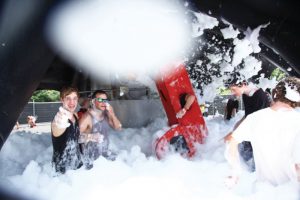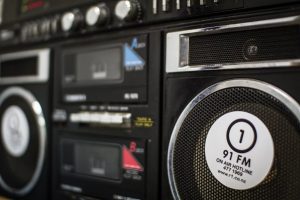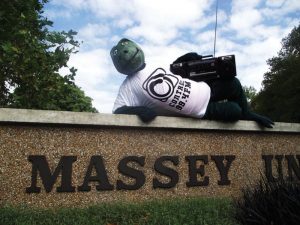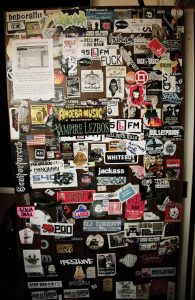Industry: Student Radio (Part 2)
Industry: Student Radio (Part 2)
NZM’s February/March 2013 issue included Part One of a look at the current state of our student radio broadcasters and the plainly unsuccessful adoption of the Student Radio Network as a collective brand. What with the need to introduce the subject and the fascinating story of Christchurch’s earthquake-reshaped RDU, we ran out of room to cover off any more of the stations that fit under the ‘student radio’ umbrella.
Two decades ago all our major university campuses had their own radio broadcast outlets. Student-focused radio filled an important role in on- and off-campus communications as well as the wider social, political and creative environments. Those days passed with the gradual erosion of Government funding to tertiary institutes, changes in the make up of the student body and most critically the introduction of non-compulsory student association membership.
In 2013 only the three stations included in the following pages can accurately be called ‘student radio’, in the sense of being on-campus and student body owned and controlled. In the capital, Radio Active was sold by Victoria University in the early ’90s and although fitting NZM‘s editorial bill, was reluctant to be included in our coverage given its wider public broadcasting role aspirations.
Radio One 91FM
University of Otago, Dunedin
Only two years ago the Otago University Students’ Association seemed intent on ditching their then 27-year old campus station Radio One. As the country’s other student bodies, the OUSA was already under the financial pump and facing the further income-stripping threat of the Voluntary Student Membership Bill had engaged international accounting firm Deloitte to look at their business.
The Deloitte recommendation to sell the station sparked widespread publicity and was hotly debated nationwide. An online petition led by the station management, staff and volunteers sought support from listeners and stakeholders nationwide. The result was that over 140 written submissions were received from a wide cast of musicians, industry figures, funding authorities and interested parties – overwhelmingly in favour of the Otago University Students’ Association retaining Radio One.
After a month-long submission window, the talk of sale was rejected by the student executive. Radio One 91FM remains owned by the OUSA and is not for sale.
Sean Norling is Station Manager. He started at Radio One as a volunteer in 2002, hosting the Subterranean Guide Show. He was subsequently employed as Promotions and Programme Manager in 2007, made Operations Manager in 2009 and became Station Manager in October 2010.
The station is housed in the OUSA Building, Level One, 640 Cumberland St in Dunedin. It has seven paid roles and around 80 staff in total when presenters, co-hosts and various other volunteers are tallied up. Constitutionally it is run by Planet Media Dunedin Ltd, which is a fully owned subsidiary of OUSA. Norling reports to Planet Media and the GM of OUSA. Planet Media’s governing board includes the elected OUSA President and Financial Services Officer, plus a couple of other industry specialists. Norling says the station is heavily student focused.
“The majority of the volunteer base is currently students. The programme has strong leanings towards academic programming and university department content. Listenership is approximately 50% student to non-student (or past student). Figures indicate it runs at about 17,000 listeners per week, much more if university transmission spots are counted as listenership. For example Radio One has speakers set up in the University Archway, which is one of the heaviest foot traffic areas in Dunedin.
As he says, the quarterly commercial listener surveying doesn’t favour the station’s more transient student/alternative market, and isn’t undertaken. Recent Otago University QAU (Quality Advancement Unit) surveys encouragingly suggest that student satisfaction is higher than in previous years.
“We’re about variety. We’re about diversity. We’re about goodness. Our DJs cover everything from punk-pop, future funk to bangin’ bhangra beats, catchy synth singles to cosmic soul death disco. Planted at the heart of urban culture, sorting the gold from the gunk and turning it up – that’s us!
The station’s heavy rotate ‘A Playlist’ gives top songs just 10 – 15 spins per week – no commercial radio-type saturation here. The weekly Top 10 feature is the Radio One Top 11, which airs 6-7pm on Tuesdays. Since its inception Saturdays 4-5pm is theaudience chart show.
Radio One’s Music Director, Aaron Hawkins has been in the role since 2010. There is a strong emphasis on local, emerging music. With a stated minimum of one third NZ music, Radio One has lately been averaging 42 – 46% local content across the board according to Norling.
“The Breakfast and Drive shows are traditionally the most popular. Outside of ‘run of station’, which is to say weekdays 7am – 7pm, all shows are specialist/genre programming. They include (but are not limited to) hip hop, retro, experimental, heavy, dubstep, DnB, EDM, electronica, psychedelic, new release, jazz and classical.”
Financially, the simple goal is for the station to break even. Revenue from advertising and sponsorship is enhanced with funding by NZ On Air and the OUSA, which contributes a varying amount year to year. ($38,000 in 2012.) Last year Radio One received $100,000 in total from NZ On Air, of which $20,000 was for Just Landed, a series of 15 hour-long programmes about new NZ music.
“The $80,000 is split across four successful propositions,” explains Norling. “We have a NZ Music Week in May and a Battle of the Bands-styled programme / live event with a broadcast outcome. The Local is a weekly two-hour long 100% NZ music show and Remote Control Sessions is a series of 19 live to air remote broadcasts.”
Radio One’s output goes to a transmitter on Mt Cargill, from where its 34dBW broadcast power provides a transmission radius of about 50km, depending on sightlines. It also streams 24/7 online.
The station’s weekly Onemail e-newsletter is a model of its type, covering the week’s feature CD, promotions, giveaways, the Radio One Top 11 and voting, plus links to recent programme streams.
The Onecard (‘unlocking awesomeness forever’) gives holders discounts on a pile of useful stuff like pizzas, burgers and curries, various gigs, WOFs, bar drinks, clothing and DCC rubbish bags. It has a $10 price but in 2013 is available free to all 24,000 Otago University / Polytechnic students.
Free 91 Club Nights take place monthly at various spaces in Dunedin and seek to cover a variety of music genres and venue cultures.
Radio One 91FM stands out as the one station within the Student Radio Network that enjoys a strong relationship with each of the others, which Norling ascribes to having a strong identity, being fiercely independent, not losing sight of the fact that Radio One is a student station first and foremost, and a good dollop of entrepreneurialism and lateral thinking.
It is also part of the European Radia Network (www.radia.fm) which, according to its site, ‘…has become a concrete manifestation of the desire to use radio as an art form… claiming that space for creative production in the mediascape and cracking apart the notion of radio is what Radia does.’
This puts Radio One into a networked fold of international stations which lead the way in innovative and sometimes challenging radio. With the threat of a station sell-off now a fading memory, Norling says that this year they are focusing on operating plant upgrades, hosting more live events and doing more outside / remote broadcasts.
“There are multiple programming initiatives that we are currently exploring. Radio One prides itself on being innovative.
Radio Control 99.4FM
Massey University, Palmerston North
Massey University also has a major presence in Wellington and Auckland but of course has its home campus in Palmerston North (student roll about 9000), which is where Radio Control is based.
The station manager role has been regularly rotating in recent times due to changes in organisation structures and some pursuing other career options. David Stevens, who has been a volunteer and listener for eight years, became Station Manager in December last year. He has worked within the music community for the past three years and says he has always had a passion for the independent music scene.
Radio Control is 100% owned by the Massey University Student Association with, according to Stevens, a degree of autonomy provided at an operational level. Station manager is the only full time position along with two part time paid roles (breakfast show host and production co-ordinator) and a volunteer base of around 60 people – largely current or recent Massey students, but including a number from the wider community. Stevens reports to the MUSA GM, who in turn reports to the MUSA board.
The station is housed in the MUSA building, in the concourse of Massey’s Turitea Campus in Palmerston North. It’s pretty flat round those parts, and the signal is transmitted from campus off the Social Sciences Building, with a broadcast power of 22dBW. Terrestrial listenership is estimated at 6000. The station also streams live 24/7 at www.radiocontrol.org.nz with selected podcasts also available from the website.
First going to air from a caravan in 1981 as Masskeradio, the station has since also been known as Radio Massey and been housed in several locations around the campus. Stevens says Radio Control (which name was adopted about 1997) is well known and respected as the first point of call for an alternative to commercial radio.
“We are both student- and public-focused, which reflects the funding bodies which keep us running.”
Those income sources outside of local business advertising are NZ On Air and Massey University. NZ On Air’s annual funding of late amounts to $60,000, going towards the broadcasting of the Local Show (one hour weekly of music from the Manawatu), Manawatahi Time (a Maori-focused two-hour weekly show) and Live To Air, which is a mix of local and not-so music concerts broadcasted live to air.
As with other NZ On Air funded alternative (student) stations, there is a long-established contract requirement to have 30% NZ music content, but Stevens says the station plays closer to 45-50% Kiwi music. Decisions about the playlist ultimately sit with him as the station manager, with some input from staff and volunteers.
“We have a 100-song playlist which is updated weekly and has a tiered rotation system. There isn’t really any basic music statement, which I suppose is a statement in itself. We are an alternative radio station – which leaves a nice big variety of music in front of us – and we try to keep an open mind for all of it.”
Continental Breakfast and the Drive Show are the most popular playlisted shows. A weekly Top 10 is featured during the Friday breakfast show, currently presented by Corey. The audience weekly top 10 plays every Saturday at 6pm.
There are 16 specialist genre shows featuring each per week, covering genres from jazz to blues, punk, metal, indie, house, DnB, dubstep, electronic, hip hop, hardcore, Latin, psychedelic and trance.
Radio Control doesn’t have any loyalty programme or card. The station supports and helps fund plenty of local shows, a few running a few itself, and plans to do a Battle of the Bands-type event in the future. Although not long in the job, Stevens happily reports that Radio Control is stable and building. He’s hopeful that in the future the broadcast will be streamed at the other Massey campuses.
“With the funding we currently receive we are able to survive even after VSM. We intend to grow and expand as a station, embracing the way that the internet has become a huge part of all types of media now, and continue to provide an uncompromised alternative to commercial radio. We see ourselves and others on the SRN as a platform for acts both nationally and internationally that wouldn’t get the time of day from other stations.”
95bFM, Auckland
Auckland University
 As evidenced by the fact that the loose coalition of university-oriented radio stations is still typically referenced as ‘the bNets’, the biggest of the nation’s student associated stations is Auckland’s 95bFM.
As evidenced by the fact that the loose coalition of university-oriented radio stations is still typically referenced as ‘the bNets’, the biggest of the nation’s student associated stations is Auckland’s 95bFM.
Due to celebrate 44 years of broadcast this NZ Music Month, bFM also lays claim to being our longest-running independent radio station. Appearing first in 1969 as a capping stunt, ‘Radio Bosom’ initially broadcasted illegally from the Waitemata Harbour. The brand name 95bFM was adopted in the early ’90s.
bFM’s history is not only long, but illustrious, particularly in the context of its DJ/presenter history. Many of our top broadcasters and media personalities have established their careers on air there. Well known alumni include the likes of Marcus Lush, Graeme Humphries, Bill Kerton, Russell Brown, DJ Sirvere, Mikey Havoc and Jeremy ‘Newsboy’ Wells, Noelle McCarthy, Wallace Chapman, Otis Frizzell, Nick D and Connor Nestor alongside numerous others.
The Auckland University Students Association owns the station, which is housed in a warren of offices and studios (a second studio is used for ad production and another for news reading and off-air content production) on the second level of the Student Union Building, at the rear corner of the university’s main quad.
The broadcast is transmitted to the greater Auckland region from the Sky Tower, with an output power of 40 dbW. bFM has been internet broadcast via www.95bfm.co.nz since 1998. Two different streaming rate options are provided, 48kps for broadband consumers and 32bps for those without.
Although a number of employment roles have disappeared in recent years, bFM remains far and away the largest of the nation’s student stations with 15 paid employees and about three times that number of volunteers.
Pennie Blair has been bFM’s Programme Director since 2011. She started with the station as Office Manager, primarily looking after credit control, in April 2006, becoming Operations Manager in 2009 when then Station Manager Helen Mobberley left.
“I’ve been a keen supporter of 95bFM as soon as I found it when I was at school, around 13 years old. It has always been the only station I’ve ever listened to after that. I feel that it has totally defined how I’ve lived my life, and what I’m into.”
In 2008 Manu Taylor, who had established his commercial radio credentials as the PD of urban Maori station Mai FM from 1966 to 2006, was engaged by the board of directors as Station Manager. Taylor reports to AUSA and to the (unpaid) board of Campus Radio BFM Ltd (incorporated in 1988), which includes Chris Hocquard, Ella Henry and Paul Taylor. The shares in that entity are 100% owned by the AUSA Media Trust, meaning that bFM remains owned by the students of Auckland University.
The change came about because of concerns at the time that the existing student executive were looking at selling assets previously funded by compulsory student fees. It was in the same time period that Waikato, Wellington and Canterbury University’s radio broadcast rights were off-loaded to commercial entities by their respective students associations.
Station lawyer Chris Hocquard explains that the trust is to ensure stability and focus, pointing out that newcomers to the student association need continual re-education on what bFM is there for – that it has considerable social importance in its support of NZ music, arts and culture, rather than value as a commercial asset. bFM has seen progressive internal structure changes since as the radio marketplace has changed. Big profit days are past, the board seeking to maintain a positive cashflow in the face of the declining advertising market, Hocquard describing it as “… a bare bones broadcaster” in which everyone has at least two roles.
Music selection now sits with Blair and Taylor, with some input from the DJs. NZ music gets a minimum of 30% airtime, but is typically around the 35 – 40% mark.
“We have eight different main categories on rotate; Awesome, Best, Current, Festival, New, Gold Best, Gold Good, Recurrent Best and Recurrent Good, and a database of 36,000 songs available for DJs to play with their 50 DJ choice.”
On week nights the period from 7pm to 1am is made up of specialist shows that are 100% DJ choice. Overall the station currently broadcasts about 51 specialist hours out of 168 play list hours – close on 30%. Blair says that the 50,000 listenership is predominantly aged 18 – 45 years. The proportion of student listenership isn’t assessed and as with the other Student Radio Network stations, the commercial radio-focused ratings are eschewed.
“We used to buy into it, but decided we wanted to be truly independent and not curtail to measurement criteria of commercial stations,” she says. “bFM is the leading independent radio station in Auckland – ‘all other radio stations are shit’ – that’s our slogan.”
According to the website, the station’s mission is ‘…to be the innovator, leader and indicator of contemporary music and lifestyles… We’re passionate about music, just like you. We think that radio is better when it’s free from commercial pressures, and that it should be challenging without being inaccessible.’
“We try and include a wide range of music. We celebrate diversity and feel we are defined by what we say ‘no’ to,” Blair explains.
NZ On Air funding makes up approximately 20% of the station’s operating costs. For the last three years the basic public funding provided has been $180,000. Blair says the funding supports the weekly Top 10 and the station’s long running weekly NZ music show ‘Freak The Sheep’ (currently hosted by Silke Hartung), plus various annual events held over the year that promote NZ Music – bStreet, Summer Series, Fancy New Band etc.
In 2011 that annual NZ On Air support was enhanced with $69,000, for 22 hour-long shows looking closely at notable Kiwi EPs, ‘Extended Play’. In 2012 there was $20,000 provided for 10 ‘True Fan’ shows, which the station itself produces. The NZ On Air website shows a further $104,000 for a year of ‘The Audience Unreleased Chart Show’. In fact that’s produced by 95bFM under contract to Amplifier Holdings, the actual recipient of the funding.
Breakfast and Drive are identified as being the station’s most popular shows, alongside Morning Glory (weekdays 9am – noon), Bright & Urlich (with long time radio personality Peter Urlich on Saturday mornings) and ARC Radio (with The Arc party crew on Thursdays 7 – 9pm).
The station’s loyalty programme is the $9.50 bCard which allows discounts from a range of food and entertainment providers, but more importantly ownership gives listeners the chance to win prizes on-air. The weekly bMail e-newsletter includes programming updates, tour and gig info, bCard discount details, giveaways and the station’s weekly Top 10 results. The station’s popular long-running Summer Series outdoor in-the-park gigs have become erratic in recent years as council regulations have made it more challenging to stage. bFM were set to go with a Summer Series this year, but Auckland City Council delays on the liquor license made it difficult to secure sponsorship.
“We try to do the bStreet event annually where we take over an inner city district (this time K’Rd on May 2nd – as we did last time). We curate seven different spaces – Whammy, Wine Cellar, Galatos, Verona, Coco’s Baretta, Arcade and Method & Manners – and fill them with great bands and DJs. The only entry required is a bCard. It’s a great opportunity to showcase bands that feature on the bFM play list all in one area, on one night.”
Since its watery start, bFM has ridden a number of waves. Today the station’s ongoing existence effectively depends on student will.
“95bFM has always had the ability to adapt to whatever is thrown at it,” says Blair. “Founded in 1969, it has its 44th anniversary in May this year. It may have its ups, downs, and competitors but we have an incredible team of people involved, who always want the best for 95bFM and are completely passionate about music. Our fundamental goals are to play great music and support local bands to make great music.”




